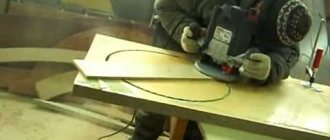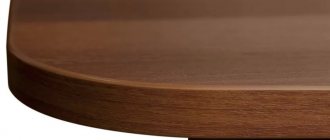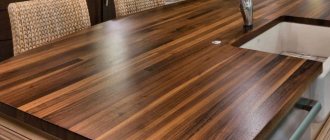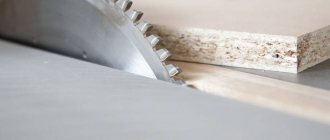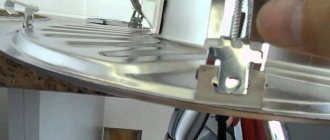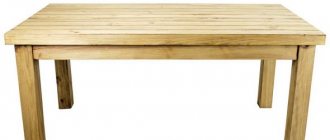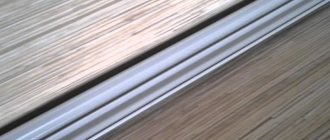Cutting round holes in plywood
Often, when repairing or installing various wooden products, it is necessary to drill a perfectly round hole.
In this article we will try to highlight all the ways in which such a hole can be cut. Options with the use of special tools, as well as without them, will be considered. How to cut plywood
A hacksaw with a very narrow blade, a jigsaw, a drill saw and a round file are among the hand tools that can be used to cut curves.
It is the narrow blade that provides maneuverability to the hacksaw, but for the same reason it is extremely difficult to operate. You must have a steady hand and an attentive eye to prevent deviations from the markings. However, do not try to work quickly. On the contrary, it is better to advance in small spurts. This will help you hold the saw handle more confidently and guide it exactly along the given line.
It is better to cut out small round or oval holes and “narrow” curves using special tools - a drill saw and a round file, which can also be used to clean out curves.
However, the most suitable tool for cutting rounded parts and holes is an electric hacksaw. Its advantage is not only that it saves energy and time. The included set of interchangeable blades with different teeth allows you to choose a blade for sawing almost any type of workpiece, be it wood, plywood or chipboard. In other words, an electric hacksaw can rightfully be called a universal tool.
Inserting a sink according to a template
The sink is one of the most important elements of kitchen equipment. If you decide to cut your sink into your kitchen worktop yourself, the first thing you need to do is prepare an exact template.
First, transfer the outer outline of the shell onto a thick sheet of paper. Next, measure the width of its sides, which will rest on the tabletop. Usually this is 2-3 cm. Now step back from the outline drawn on the paper, inward by the width of the side and draw a parallel line. This will be the cutting line.
When applying markings, make sure that the position of the template itself on the plate is correct. Of course, if all the corners of the sink are symmetrical, then nothing bad will happen if, according to the markings, it appears to be in a mirror image. But if the sink has the shape of a trapezoid and the roundings at the front corners differ from the roundings at the back, then under no circumstances confuse the front and back parts.
Criteria for choosing a quality option
Below we will look at the main types of devices for cutting holes in wood, but for now we will outline the criteria that any option must meet, regardless of its modification:
| Reliable manufacturing material | Of course, it is unlikely that you can determine this criterion by eye, so it is best to ask the seller for a quality certificate for the product. Unreliable counterfeit versions from China most often do not have any documents. |
| High quality performance | Examine the product carefully: the surface must be smooth without flaws or defects, the cutting part must be carefully sharpened. If you purchase a long wood drill, check whether it is level; this can be done by eye or by rolling it over a flat surface - any irregularities will be immediately visible on it. |
| Good packaging | Low-quality fakes are most often packaged haphazardly, moreover, there are mistakes in the words. No well-known brand will allow itself unsightly packaging, remember this. |
| Price | Price is also an indicator of quality; as a rule, the most budget options do not last long, especially when it comes to large-sized drills and fixtures. After all, they are subjected to very high loads during operation. |
Advice! To be guaranteed to purchase a quality product, be it an electric jigsaw for wood or a circular saw, you need to contact official representatives of a particular brand or buy products from well-known stores that care about their reputation and do not sell cheap fakes.
Cheap core drill sets are so unreliable that they may only last for a single use
Electric hacksaw
If you need to cut a round-shaped part and saw a round hole in the workpiece, then an electric hacksaw is the most suitable tool. With its help, you will save effort and time, since such a saw has great advantages over a manual one. Thus, the blade of the electric hacksaw is narrower, which provides increased maneuverability. Further, it has replaceable blades with different teeth, which allows you to process workpieces of any type, that is, wood, plywood, chipboard (it is no coincidence that the tool is also called a jigsaw).
To cut a section inside the workpiece, a hole is first drilled for a hand saw. But if you have an electric hacksaw, then this is not necessary. The tool is brought to the workpiece with a slight tilt forward and turned on in this position. The saw will cut the hole itself. Just don’t put too much pressure on the body - this can lead to breakage of the saw blade.
Drill saw
Neither a hand saw nor an electric hacksaw will help if you need to cut a small hole in the workpiece - less than 10 cm in diameter. A jigsaw may also be useless if the workpiece is large. In this case, the most suitable tool is a drill saw. With its tip it bites into the wood like a drill and thus makes a “starting” hole for further cutting. Externally, the saw is similar to a round file with the difference that its shaft is surrounded by a spiral around the cutting edge.
Drill saws are available with interchangeable attachments of various diameters, designed for processing both soft and hard wood, as well as a variety of materials made from it.
The working body of a drill saw is a metal rod with a cutting tip, like a gimlet, and a cutting edge that goes around the rod in a spiral.
This is what the narrowest of hand saws looks like. Thanks to the fastening unit, the blades in the hacksaw can be changed depending on the nature of the material being processed.
Drill attachment
One of the most popular and convenient options for cutting a hole is a special attachment for a drill. It is made in the form of a crown comb and has a rounded shape. With this attachment, cutting holes occurs quickly, and they turn out quite smooth.
drill bit for holes
Nozzles come in different diameters, which allows you to cut a hole of the required diameter. If you have already prepared a hole, we can advise you to try your hand at options trading.
Drill
You can also cut a large hole using a drill. To do this, it is necessary to pre-mark the outline of the hole to be drilled. Next, use a small drill to drill through holes along the contour prepared in advance. Next, using a jigsaw or a very sharp knife, we cut off the holes, thereby connecting the holes. After which you can smooth the circle using sandpaper of various grain sizes.
Chisel
You can also cut the required hole using a chisel. It is enough to remove the wood layer by layer along the contour. This option is the least suitable for interior decoration. The hole must be smooth, which cannot be achieved by using improvised and unsuitable materials for the job. The best option would be to use a drill bit. The hole is even and has smooth edges.
Thus, to summarize, it becomes clear that you need to choose a tool for cutting a hole based on your goals. If you need a high-quality cut, then you cannot do without a special tool.
Shape cutting technologies
Jigsaw
As we noted above, a jigsaw will come in handy if we are looking for how to cut a word out of plywood or make other parts of complex shapes:
- We transfer pre-printed drawings or templates onto the workpiece using carbon paper.
Figured carving with a jigsaw: photo of the finished product
- If the structure has through sections, we make starting holes with a thin drill.
- Insert a file or jigsaw blade into the hole. Secure the free end of the file with a fastening screw or clamp.
- We make a cut along the intended line, pressing the workpiece to the workbench. The saw moves either automatically (for electric jigsaws) or manually.
After all the arc elements have been sawn, we remove unnecessary areas and process the finished part with a file or sandpaper.
Finished hole
Fraser
A furniture router is great for cutting out thick plywood. Of course, you can’t make a complex shape with it, but cutting an arc or circle is easy:
- We fix the standard ruler included in the router in the center of the circle using a self-tapping screw.
- If the length of the ruler is not enough, you can assemble a simple bracket from a metal profile or wooden planks.
- By rotating the cutter along a fixed radius, we select a groove along the circumference, resulting in an almost perfect hole.
Bracket for router: with it you can cut a disc of almost any diameter
Note! When calculating the diameter of the circle, you should take into account the dimensions of the working cutter. The instructions for the device will tell you the exact numbers.
In this way, you can cut not only circles, but also individual arcs - for example, in order to make grooves for furniture brackets.
Using improvised means
For shaped elements, it is advisable to have special devices, but any craftsman may need to make a round hole in a slab of laminated veneer. Below we will tell you how to cut a circle from plywood when you have nothing at hand. Well, almost nothing:
- To cut plywood, use a wooden strip with two nails.
- One nail is driven through the strip into the workpiece, exactly in the center of the hole being made.
- We drive the second nail into the bar so that the point protrudes on the wrong side by at least 5-10 mm. The distance from the first nail should be equal to the radius of the hole being made.
- Rotating the bar, use the tip to draw a groove on the plywood, deepening it with each turn.
- Instead of a stick, you can use a strong cord. The operating principle remains unchanged.
Diagram of "threading" using nails. The sharper the nail used, the faster the hole will be made. It should be noted that although the price of such a device is low, it is worth using it only when other methods are not available: the edges still turn out to be far from ideal.
Combined methods
The next method for cutting a circle from material can be called combined. Not only a milling machine will be used here, but also other simple tools. In some cases, the use of a tool can even eliminate working with a router.
Jigsaw, nails and chisel
The next option for cutting a circle is to use an electric jigsaw. Here you will not encounter much difficulty if you select the right saw in advance. It comes in different thicknesses, which can greatly affect the final size of the cut circle.
If the material where the circle is thin, then you can get by with just one jigsaw, having first outlined the circle with a compass and marked its middle. But if the material is thick after the jigsaw, you may need to complete the work with a router.
The last method is based on the use of simple nails. You need to take two nails, one of which is driven in the center, and the other is pulled on a rope along the radius, then cut in a circular motion. This is similar to the first method, when the work is completed with a router. But if the thickness of the material is insignificant, you can do without it.
The outline of the future circle can be pressed even with an ordinary chisel or a sharp construction knife. First, make a circle with a compass, and then begin to forcefully move the knife along its contour. This will press the material somewhat.
You can do it in two ways. The first is to modify the circle with a router, the second is to punch it with a hammer. The case with a router is more correct if the material is quite strong and is not pressed through enough. But it’s good to work with a hammer if the material is pressed through with virtually no problems.
So, the basic methods of how to cut a circle with your own hands using a router, and also partially without it, are considered.
It's best to work with standard sizes when you don't need to customize or invent anything.
But if not possible, you can use these tips.
Plywood (and to a lesser extent other sheet materials such as chipboard or oriented strand board) has significant decorative potential. If you have a fairly simple tool and certain skills, you can cut almost anything out of plywood. But in order for the parts obtained as a result of such carving to look quite presentable, the master should have a few tricks in stock. We will talk about them in our article. Curvilinear cutting is difficult only at first glance
Design and its features
Each jigsaw has a so-called support sole. It always rests on the part that needs to be sawed. Due to this, the accuracy of work is noticeably increased.
The soleplate can be easily rotated to make bevel cuts. Some manufacturers produce in which the main tool is fixed only at a certain angle.
The file acts as the main cutting tool. Tooth spacing, sharpening method, size, shape, materials - literally every model has its own. 75, 85 and 100 millimeters are the most suitable lengths if you need to cut materials of low density. The saw step size also becomes a fairly important parameter.
- Metal requires a pitch of 12 millimeters.
- For wooden products it is from 2.5 to 4.
Ballerina device
The design of this tool is simple; in the most common version, it is a bracket with a drill fixed along its axis of rotation. This center drill not only marks the center of the future large hole, but also provides support for stable rotation of the entire device. On two opposing arms of the bracket there are two carriages with cutters fixed in them. The bracket rod is specially marked, which allows you to install carriages with cutters with fairly high accuracy. Having spread the lateral incisors to the required distance, they are fixed on the bracket with clamping screws, after which work begins. It would be a good idea to check the spread of the cutting edges using a caliper.
In addition to this, there are several more modifications, in which there are one, two or even three incisors. They differ in the different design of the bracket - it can be a disk along which cutters move in special slots to adjust the diameter. Also, in the axis on which the ballerina rotates on wood, a hole is drilled, straight or at an angle, and a cutter is inserted through it, fixed with a locking screw. This also makes it possible to adjust the diameter of the resulting circle, and one cutter does a good job, especially if it is made of good steel and used correctly.
The shank of the central axis can be round or have a special shape for fixation in the SDS chuck. Quite often, knives of various shapes are used, capable of removing straight or rounded chamfers where necessary.
Why do you need a plywood circle?
Before you think about how to cut a circle in plywood with a jigsaw
, you need to clearly understand why it is needed. Subsequently, either the resulting round-shaped blank itself or a plywood sheet with a hole of the correct shape can be used.
Where a round piece of plywood can come in handy:
- for making various crafts and templates for them;
- used as a base for a wall clock;
- used for subsequent figure cutting or decoupage;
- act as the seat of a stool, the top of a kitchen or coffee table, etc.
- for creating various souvenirs, for example, boxes, etc.
You may also need to cut out the correct circle from plywood for subsequent use of a sheet with a hole:
- installing a mortise sink into the countertop;
- obtaining a ceiling with a cutout for round-shaped lighting fixtures (spotlights or one chandelier);
- for the production of furniture with decorative facades and other elements, etc.
Recommendations for selecting tools
Ready-made plywood circles
Circle cutting device
Many people cut parts out of plywood more than once, but mostly they had to make straight cutting lines. It is not often necessary to cut out round or wavy parts; few people dare to make a circle out of plywood. Therefore, this task at first glance may seem impossible. For figure cutting you will need the following tools:
- An ordinary jigsaw. A tool often used for DIY sawing of thin sheet materials. However, thick thicknesses are beyond his strength;
- Jigsaw. Such power tools are divided into two types of devices: regular, in which the file is located vertically, and for artistic work, in which the working element is a steel blade, as can be seen in the photo. A regular jigsaw is suitable for working with thick plywood, but you won’t be able to use it to make an even circle of plywood. But curved elements, such as letters, can be cut out with an artistic jigsaw, which is equipped with a band saw. Thus, for high-quality performance of various types of work, an appropriate device is selected.
- With more complex equipment, such as a router, a circle of plywood can be cut very smoothly. It is of course more difficult to control, but it can be used to cut a circle of plywood from sheets of sufficiently large thickness. The quality of work on such a machine is superior to other cutting methods, and the cut of the wheel is smooth.
Recommendations for working with plywood
- Templates for drawings should be placed on the workpiece sheet so that areas with damage and flaws then go to waste, and clean areas are located under the drawing, that is, they later become a finished product;
- Before cutting a circle from plywood with a jigsaw, you need to make sure that the material is completely dry. Since humidity increases the resistance of plywood, and as a result, either the veneer may delaminate or the tool may break;
- To ensure that the edges of the cut are free of notches and burrs, you need to cut it with a jigsaw along the grain of the veneer. With a hand jigsaw, on the contrary, you need to cut across the veneer fibers, although chips may form, but there is no risk that the file will deviate from the cutting line;
- As soon as it becomes noticeable that the cutting teeth have become dull, you immediately need to change the working blade or saw.
Curly cutting methods
When starting to cut out with a jigsaw, a sketch of the design is first applied to the sheet using carbon paper. The initial holes are drilled with a drill. A file or working element of a jigsaw is inserted into it and the free edge of the file is fixed using a clamp or screw. Next, sawing is done according to the template transferred to the plywood. Then unnecessary elements are removed, and the workpiece is sanded along the edges with sandpaper or processed with a file. The video shows this process.
A furniture router is not suitable for cutting out complex shapes, but cutting a circle out of plywood evenly is very easy. The standard ruler of this machine is fixed in the center of the circle using a self-tapping screw. When the cutter begins to rotate along a given radius, a completely even circle is cut out. To correctly calculate the diameter of the circle, it is necessary to take into account the dimensions of the cutting cutter. You can correctly navigate this issue by first studying the instructions for the equipment.
Jigsaw
When cutting holes or curves in small workpieces, sometimes you can’t do without a jigsaw. Replaceable blades with teeth of different shapes and locations allow you to work with wood of different densities. However, it should be taken into account that the depth of the cut is limited by the arc of the jigsaw, that is, the saw blade will not be able to move further than 30 cm from the edge of the workpiece.
Very thin, narrow saw blades can be easily damaged if the jigsaw is used incorrectly. The saw must be operated with careful, methodical movements. The main thing is to prevent the canvas from skewing. Otherwise, small and light workpieces will begin to move with the saw, which may ultimately lead to the blade bursting.
The thinnest jigsaw blade will “master” the narrowest curve, but only in small workpieces, since the advancement of the blade is limited by the arc of the jigsaw.
Key rules
To make the sawing process simple and fast, you must follow the basic key operating rules:
To ensure that the edges of the plywood are even, it is better to cut along the blade.
- You can only work with dry material, since humidity increases the resistance of the material, as a result of which the veneer may begin to delaminate;
- it is necessary to change the cutting blade immediately after the first signs of dullness of the teeth appear;
- It is better to work with a jigsaw along the fibers of the material, so the edges will be smoother;
- Use a hand jigsaw to cut across the grain of the veneer.
To ensure safe work, you must adhere to the following recommendations:
- securely fasten the sawing table and the file in the frame;
- the jigsaw must have serviceable and well-fitted handles;
- You should not press the jigsaw too hard, trying to “help” it, this will only lead to an acceleration of dulling of the working blade;
- It is best to make straight and long cuts with a wide blade, so the cutting process will go faster;
- You must always see the markings, so sawdust must be removed from the material being cut by hand, and under no circumstances should you blow it away, as it can get into your eyes.
Following these simple rules will help a beginner learn how to cut circles with a jigsaw and make his work easier.
How to draw ellipses
An ellipse is a rather complex shape, but to draw it on paper, you only need two thumbtacks, a piece of string and a sharpened pencil.
Attach two buttons to the surface of the workpiece at some distance from each other. Take a piece of rope, tie both ends into a knot and hook the rope onto the button heads. Now, with a pencil, draw a line that the stretched rope allows you to describe. You can change the shape of the ellipse at your discretion.
The distance between the two focal points of the ellipse is indicated by buttons. If you guide a pencil within the boundaries assigned to it by a rope, then the outline of an ellipse will appear on the paper.
The ellipse shape can be larger or smaller, thicker or narrower, depending on the distance between the buttons and the length of the rope.
A little about safety
To protect yourself from injury when working with a jigsaw, following these rules will help:
- Carefully study the operating instructions for the tool before using it, check its serviceability and the presence of all components;
- stop using unsuitable saw blades;
- manual jigsaws cannot be held by the frame; a special handle is provided for this;
- In electrical tools, the integrity of the insulation must be checked; its cutting part must be limited by special devices;
- When working, you must always use protective equipment - a shield, goggles, a respirator, gloves that will protect you from fine dust and shavings;
- at the workplace, be sure to provide good ventilation to remove dust and vapors of paint and varnish substances;
- carving is carried out slowly, keeping the distance between the hand and the blade;
- all electric heating devices should be located no closer than 5 m to the workplace;
- Upon completion of all work, the jigsaw is disconnected from the network.
Wood grinding wheel for grinder
This is not exactly a wreath, but the base for the wreath is a frame on which you can attach various decorations. But the base itself is very beautiful - natural, made from natural materials, smelling of the forest! Making such a wreath is not at all difficult.
True, you need to spend almost a couple of hours on production. The main feature of the technology for making this wreath is that it turns out to be very SMOOTH - round, without branches sticking out in different directions. This is how to make such an even wreath that will be discussed in my MK. For work you will need: birch branches - preferably not dry, but flexible, which have only recently fallen from the tree; they can be collected under any tall and not young birch tree - it is better to collect long and thin branches, it is more convenient to weave a wreath with them - the approximate number of branches - see.
Conclusion
We hope that thanks to the information presented above, the question of how to cut a figure from plywood will not cause you any difficulties. Of course, figured carving on sheet material requires a certain skill and accuracy, but if you have a suitable tool, even a beginner should not encounter any particular difficulties. In the video presented in this article you will find additional information on this topic (also find out how to make a box from plywood with your own hands).
Source: fanera-info.ru
Final touches
Once you've finished your cut, sand down any tool marks. Sandpaper of different grits will help you with this. Use a variety of solvents to remove tape residue.
With these simple steps we have the round hole we need.
Ways to minimize chipping
An additional reason for the formation of chips may be misalignment of the saw teeth. Therefore, the first thing you need to do is purchase a tool with a straight cut (often Bosh files). However, it should be taken into account that during prolonged use, such files overheat and may even bend during the cutting process. Therefore, it is necessary to take breaks from work to cool the cutting tool.
However, just replacing the saw blade is not enough and in order to cut laminated chipboard (laminate) with a jigsaw without chipping, you need to make minor modifications to the power tool. Namely, make sure that when the saw moves against the inclination of the tooth, the material does not pull out. For this purpose it is enough to make a persistent platform. You can come to this conclusion by trying to cut two sheets of chipboard at the same time. So there will be practically no chips on the lower element.
In order to make a stop pad for a jigsaw, it is enough to cut out a rectangle from any dense material (for example, laminate) with dimensions identical to the dimensions of the sole of the power tool.
Then, along the larger center line, you should make a notch and secure the resulting equipment to the sole of the jigsaw using insulating tape or double-sided tape. All modifications are ready and finishing work can be carried out in compliance with certain recommendations.
How to cut a circle?
Many people enjoy a peculiar hobby called origami and paper crafts. This is a difficult, but very entertaining business that can be compared to art. In order for the products to turn out worthy of admiration, considerable dexterity, skill and talent will be required. Almost everyone can master the technique, but coming up with something new out of paper is a much more difficult task. As they say, test yourself first in a simple task. For example, cut out an even circle from paper. To complete a seemingly simple task, you can use a variety of methods.
Cutting out a circle using a compass
A circle is a perfectly even figure, the distance from the center of which to all its edges is the same. This distance is called the radius of the circle. If the question is how to cut a circle out of paper, you can use an excellent office tool - a compass.
This device, invented by mankind, looks like two pieces of wood or iron connected to each other. At one end of such a segment there is a pencil, and at the other there is a sharp end. Using this tool, you can easily draw a circle of any diameter. I think you know how to cut a circle out of paper with scissors. This simple method is suitable for making one piece.
If you want to cut out a lot of round blanks, take a compass and use it to draw an even circle on paper or cardboard. After this, attach the blank to paper or cardboard and cut out the circles with scissors or a stationery knife. This way you can very quickly cut the required number of round pieces for yourself.
Conclusion
We hope that thanks to the information presented above, the question of how to cut a figure from plywood will not cause you any difficulties. Of course, figured carving on sheet material requires a certain skill and accuracy, but if you have a suitable tool, even a beginner should not encounter any particular difficulties. In the video presented in this article you will find additional information on this topic (also find out how to make a box from plywood with your own hands).
Source: fanera-info.ru
Templates
Shot glasses, cups, plates, pots or baking dishes - in any household there are many round-shaped objects that can be used to mark a circle. If you are making something and decide to give your product a rounded shape, then first look to see if there is a suitable template among the household utensils. To be sure, select a few items and take them to the workshop. There you can immediately try them on the workpiece and determine what is most suitable. With some practice, you will be able to make rounded lines from several round objects with different radii. Arcs of a circle can be drawn sequentially, or bridges-transitions can be made between individual arcs.
Preliminary drawing
Before attempting to trace a curve on a piece of paper, design it on a large piece of paper or piece of corrugated cardboard. Only after the result is satisfactory in all respects can you cut out a template from paper and make markings on it on the workpiece.
You can draw circles and fragments of a circle using a cup or plate by simply tracing them with a pencil.
The working process
Then measure the thickness of the nail you used and drill a hole of the same diameter in the center of the circle. Use the hole left by the compass needle as a template.
Latvia: how residents of our former republic will celebrate Victory Day
Instead of minced meat - seitan and carrots: preparing a vegan casserole Parmentier
Nun violated quarantine and got behind the wheel of a tractor: video
Now put the workpiece aside and take thin plywood. Make a large crosshair mark in the top left corner and drill through the center using a thin drill bit. Make sure your marks remain after you drill the hole.
Then make a second mark on the workpiece at a distance equal to the radius of your circle. Remember that the radius is half the diameter.
At the last mark, drill a hole with a drill of such a diameter that a jigsaw blade can fit into the resulting hole with a small gap.
Now let's move on to the part with the drawn circle. You need to drill the starting hole with a drill bit larger than the jigsaw blade. Try to drill so that the hole touches the line marked with the compass.
Germany is expecting a second wave of coronavirus and has learned to recognize it in advance
A new attraction in Amsterdam is a floating shelter for cats (photo)
Truth or joke? What will your husband be like in old age according to his zodiac sign?
It's time to put the blank and template together. Securely secure the workpiece to a sturdy surface. Insert a nail through both center holes in the blank and template, then line up the starting holes on the circle.
Now we need to attach the jigsaw to the turning template. For these purposes, I use a favorite secret: double-sided adhesive tape. It is easy to find at any hardware store. Apply tape to the turning template and insert the jigsaw blade into the starting hole. Once everything is installed correctly, press the structure against the adhesive tape for a few seconds.
Finally it was time to make the cut. Keep the jigsaw at full speed at all times, pushing forward with medium pressure. Don't worry about the tape coming off, trust me it won't.
How to cut a circle from wood using a hand router
Piggy banks are now more of a decorative element than objects used for their intended purpose. And yet, many continue to use them as a means of storing small items. By dropping just coins of a couple of rubles into them, after a while you can find a pleasant amount inside for small and sometimes large expenses.
A stylishly designed tree trunk circle can become a real garden decoration! There are several design options for this area. For example, you can arrange a flower garden there, sod it with cereals, green manure, or fill the space with decorative mulch. Each method has its own characteristics and aims to improve the soil structure, retain moisture, provide protection from weeds and some pests, and fit harmoniously into the overall style of the landscape.
The trunk circle is an area around the tree trunk, which is equivalent to the projection of the crown. Until the age of five, a tree is considered young, so it is not advisable to cover the area around the trunk with anything, so as not to interfere with the development of roots. During this period, the soil around the trees must be watered, loosened, fertilized, and ensure that it remains moisture- and breathable.
The transformation is based on a circle. The circle represents the nature of power. And it can be put into action by writing a formula in a circle.
How to make a wooden garden path with your own hands, photos and videos
There are many possibilities for organizing garden paths. Many of these methods are very simple, and these ideas can be implemented on your own, without hiring professionals and even spending a very modest amount on materials.
The second most popular material for garden paths after stone is wood in all its shapes and colors. Wood is inferior to stone in terms of reliability, but it creates a feeling of warmth and does not require serious expenditure - both monetary and time.
Even in a garden decorated in a modern style, a wooden garden path looks very impressive. We have found wonderful instructions for you on how to make a garden path from wood cuts with your own hands.
You will need:
- several tree trunks of different diameters
- saw
- varnish for waterproofing wood and protecting against mechanical damage
Tire as an effective way to avoid wood destruction during bending
Since the main problem is fiber breakage on the outer radius side, it is this surface of the workpiece that needs to be stabilized somehow. One of the most common methods is to use an overhead splint. The tire is a steel strip with a thickness of half a millimeter to two millimeters, which covers the beam or board along the outer radius and bends on the template along with the wood. The elastic strip absorbs part of the energy when stretched and at the same time redistributes the destructive load along the length of the workpiece. Thanks to this approach, coupled with humidification and heating, the permissible bending radius is reduced significantly.
In parallel with the use of steel bars in bending devices and machines, mechanical compaction of wood is achieved. This is done using a pressing roller, which presses on the workpiece along the outer bending radius. In addition, the template form in such a device is often equipped with 3 mm teeth (in increments of about 0.5 cm), oriented towards the movement of the workpiece.
The purpose of the jagged surface of the template is to prevent the workpiece from slipping, to prevent mutual displacement of fibers in the wooden massif, and also to create a small depressed corrugation in the concave radius of the part (the fibers are pressed inside the massif, therefore, problems with folds are solved).
Pressing with a tire allows you to bend bars and boards made of coniferous and soft deciduous wood with a minimum percentage of defects. Please note that parts made of relatively hard wood when bent with pressing become approximately ten to twelve percent thinner, and pine and spruce blanks become 20-30% thinner. But the positive aspects of this method include a significant increase in the strength characteristics of the finished product, as well as a significant reduction in the requirements for the presence of flaws and defects in wood blanks.
General operating rules
Despite its ease of use, the router is a dangerous tool if you use it without following simple rules. So, the basic rules for working with this unit are as follows.
- The sleeves of clothing should fit snugly to the arms. If you have long hair, then you need to pick it up to prevent it from getting caught in the cutter and then getting tangled.
- Before starting work, be sure to check the network cable for insulation damage. Damage to the cord occurs when the cable accidentally hits a cutter that has not yet stopped. Any abrasions found in the insulation must be insulated.
- Prepare the workplace so that there are no foreign objects (wrenches, screwdrivers, screws, etc.) that could get under the working tool and damage it.
- Use only well-sharpened tools (cutters). You can check the sharpness of the blade with your finger: to do this, you need to run it along the blade at an angle of 90 degrees. If the edge is sharp, you will feel the skin slightly catching on the sharp edges. Otherwise, your finger will easily slide off the blade.
- Before using a cutter with a thrust bearing, be sure to lubricate it with one drop of oil. The bearing should rotate easily and without delay.
- When installing the equipment into the collet, make sure that the cutter shank fits into it at least 20 mm.
- Each time you install a router bit, remove carbon deposits and wood residue from the edges using a soft metal plate.
- Use special safety glasses. It would be good if they were dustproof.
- Be sure to protect your respiratory system from fine dust, which is generated in abundance during milling, especially if parts made of chipboard and MDF are processed. As protection, you can use a respirator or a regular medical mask purchased at a pharmacy.
- Always secure the workpiece to the table using clamps. Holding the workpiece with one hand during processing is prohibited.
- Correctly select the rotation speed of the unit’s spindle, depending on the diameter of the installed equipment. You should also pay attention to the hardness of the wood. The higher the hardness of the material, the lower the rotation speed should be set.
- The cutter should plunge into the workpiece to a depth of no more than 3 mm in one pass.
- Before starting to process the workpiece, you should turn on the milling cutter and wait until the cutter reaches the required speed, and then begin inserting the cutter into the wood. If you start milling at low speeds or at the initial speed of the tool, the cutting part of the equipment will hit the workpiece, forming chips on it. In addition to damaging the part, the router can jump to the side and injure the operator.
- You should hold the unit so that you can see the rotating equipment and control its immersion in the material.
- Since the cutter rotates clockwise, the movement of the cutter should be directed in such a way that the blades of the equipment move towards the material, as shown in the figure below.
- The milling cutter must be held firmly in your hands, but without undue pressure on the workpiece. It should be pressed evenly and the unit should be driven smoothly, without jerking, throughout the entire trajectory of movement.
- If you work with a milling cutter at low speeds, and even for a long time, then it needs to be allowed to cool periodically. The unit should be started at maximum speed (idling) for 20-30 seconds so that the engine is well ventilated by the air flow created by the impeller mounted on its shaft.
- To stop milling, for example, the edge of a workpiece, you must first remove the cutter from the wood and then turn off the unit. But when milling a deep groove, you first need to stop the feed of the tool, turn it off, wait until the equipment stops completely, and only then remove the cutter from the recess.
Feather drill
Typically, a feather drill is positioned as a cheap and quite high-quality tool that can be used to drill a hole in chipboard or wood. The length of the shank allows you to go deep into a considerable distance; the choice of diameters up to 70 mm should also please you. However, in our experiment we will also try to make a blind (non-through) hole. So, let's go.
Already at the very beginning of the work, an interesting feature was discovered: on the packaging it was indicated that the drill is intended for drilling 34 mm holes; on the drill itself there is a mark of 32 mm. I had to take a caliper and measure.
The drill actually turned out to be 32 mm, and the indicated figure of 34 mm on the packaging remained a mystery to us for literally the next fifteen minutes. The drill tip allows you to install the tool exactly in the right place, although in our case the drilling did not require it. From the very beginning of work, the pen drill began to bite into the material with enthusiasm (not without our pressure on the drill, of course). After a few seconds, the drill was stopped to make sure that it was possible to make blind holes using a feather drill.
Theoretically, this is possible, but for this you need to have a fairly thick workpiece. Since the pen drill has a long tip, in our case, with a recess of only 6 mm, a small hole of about 2-3 mm appeared in the center on the reverse side.
Drilling a hole in the chipboard yielded the following results (see photo):
Feather Drill Entry Hole
back side
the edges seemed smooth, the inner surface of the hole wall was smooth, and with the stated drill diameter of 32 mm, the hole had a diameter of 31.9 mm. Such results deserve a rating of 5 points out of 5, although this is the first tool and perhaps one of the remaining ones can be even better. In the meantime, we believe that drilling holes in wood, chipboard and other similar materials is quite feasible for a pen drill with good results.
